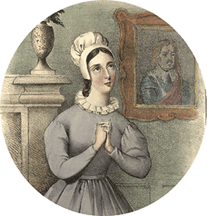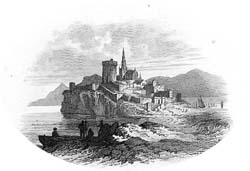|
|
Home | Corson Collection | Biography | Works | Image Collection | Recent Publications | Portraits | Correspondence | Forthcoming Events | Links | E-Texts | Contact Peveril of the PeakFirst Edition, First Impression: Peveril of the Peak. By the Author of "Waverley", "Kenilworth", &c. In Four Volumes. Vol. I. (II-IV). Edinburgh: Printed for Archibald Constable and Co. And Hurst, Robinson and Co., London, 1822. Composition | Synopsis | Reception | Links Composition
SynopsisThe background to the novel is the so-called Popish Plot of 1678, when Jesuits were alleged to be planning the assassination of King Charles II in order to bring his Roman Catholic brother, the Duke of York (later King James II) to the throne. The story centres on two Derbyshire landowners, Sir Geoffrey Peveril, an old Cavalier, and, Major Ralph Bridgenorth, a Puritan. Despite their differing political and religious opinions, they have been brought together through events connected with the Civil War. Sir Geoffrey's son Julian and Bridgenorth's daughter Alice are secretly in love, but their relationship is jeopardized when the Popish Plot divides their fathers. Bridgenorth is suspicious of Sir Geoffrey's friendship with the Countess of Derby, who, although guiltless, is implicated in the Plot. Julian, who has spent some time attached to the Countess's household on the Isle of Man, returns to England on her service, and finds that Bridgenorth has arrested his father as a Papist conspirator. He is himself arrested when trying to liberate him but is freed by his father's retainers. Meanwhile, Alice has been entrusted by Bridgenorth to the care of his brother-in-law Edward Christian. Christian hatches a plot to make Alice the King's mistress and thus gain access to the royal ear. His aim is to avenge himself on the Countess of Derby who has had his brother executed during the Civil War. To this end, he has also placed Fenella, his daughter by a Moorish woman, as a spy in the Countess's household. Fenella has long played the role of a deaf mute in order to learn her employer's secrets but falls in love with Julian during his residence with the Countess. She helps Julian rescue Alice from the King's licentious favourite, Buckingham. The vengeful Buckingham contrives to have Julian arrested under suspicion of involvement in the Popish Plot and imprisoned along with his father in the Tower of London. They are put on trial but acquitted thanks to the intervention of the King, whom Fenella has informed of Christian's conspiracy, and who feels indebted to Sir Geoffrey. The King prevails upon Sir Geoffrey and Bridgenorth to set aside their differences, and consent to their children's marriage.
ReceptionAs with The Fortunes of Nigel, the reviewers were divided over Peveril of the Peak. The Edinburgh Magazine and British Critic were altogether favourable, the latter declaring that it was 'better calculated to stand the test of criticism' than any other Waverley novel. Other journals, though, such as the European Magazine and Monthly Review felt it was marred by careless composition and excessive padding. The plot (as the synopsis above might suggest!) was widely felt to be muddled and confused. Some critics were more forthright in their censure, the New European Magazine deeming it 'superlatively bad' and accusing Scott of profanity and indelicacy, while the Literary Chronicle opined that Scott was now writing less for fame than fortune. The selling price of the four volumes, two guineas, was widely criticized as extortionate. This did not, though, prevent it matching the commercial success of its predecessors. Links
Last updated: 19-Dec-2011 |
|

 The
first galley proofs of Peveril of the Peak were already
rolling off the presses, when
The
first galley proofs of Peveril of the Peak were already
rolling off the presses, when 